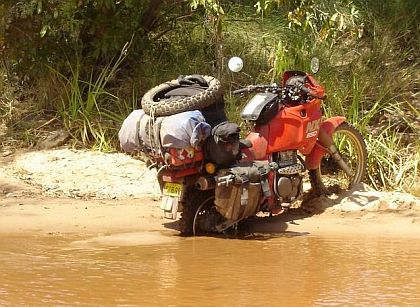Preparation = Prevention
Maintenance First!
Outpatients is beckoning when you ride a poorly maintained bike. Tyres and brakes are the most obvious areas to look after, and replace them early rather than late. Use the correct tyre for the terrain. If it’s mud or sand, you need a widely spaced knob pattern with a hard compound rubber so it will bite and grip. Rocky terrain calls for more knobs and soft compound rubber so it will give and grip. In reality, most rides cover a mix so medium compound tyres are highly recommended for general purpose riding.
When checking tyres and brake pads, consider the length of your next planned ride. You may get away with a day run, but a week-long ride calls for fresh tyres and a back-up set of brake pads, particularly if it looks like being wet.

Check for play in the wheel bearings by gripping the top of each wheel and push-pulling it from the side. If there is any play at all replace them immediately. Have a feel of the steering head bearings as well. Are they loose? Check this by putting the bike on a stand, gripping the bottom of the fork tubes and push-pulling front to back. Are they knotchy? Do they move smoothly? The correct bearing tension is when a light tap will allow the forks to fall away from the straight-ahead position. If any of this is double-dutch, get a mechanic to check it for you. Or better still, get a mate to show you how it’s done, because this is basic stuff that needs regular attention.
Give the brake and clutch controls a light oil, keep the cables lubed, and never, ever, run a worn chain. Having the back end lock-up unexpectedly is not good. Check also that your brake, tail and headlights are all working. These are all underestimated as life savers.
A clean, well-maintained bike is a safe bike, and a sure sign of a savvy rider.
The Right Gear
The next step is to protect your body. Helmets should be comfortable and as quiet as possible. Avoid models with excessive wind-noise because they will fatigue you. Goggles should have a large lens area, and again be comfortable, fitting snugly against your face. Tinted lenses are okay for paddock work but suck when there is the slightest chance of riding in the dark, which is just about every time you go on a distance ride. If you must use them, carry a spare clear lens so you aren’t riding blind after sunset.
Boots come in many shapes and configurations. Look for sturdy, well-protected buckles, stiff shin guards and reasonable ankle movement. Go for heavier gloves, because the light-weight MX ones won’t save your palms if you go down. The leather supermotard ones give much better protection while still allowing air flow. Armour? Look at it as a way to avoid penetration wounds; go for a large front panel and good cushioning that won’t shred sweaty skin. Knee guards are a simple concept but watch for over-large velcro panels on the straps, which will rub your legs raw in minutes.
And none of this stuff is any good if it’s not on. Wear your protective gear every time you ride.

